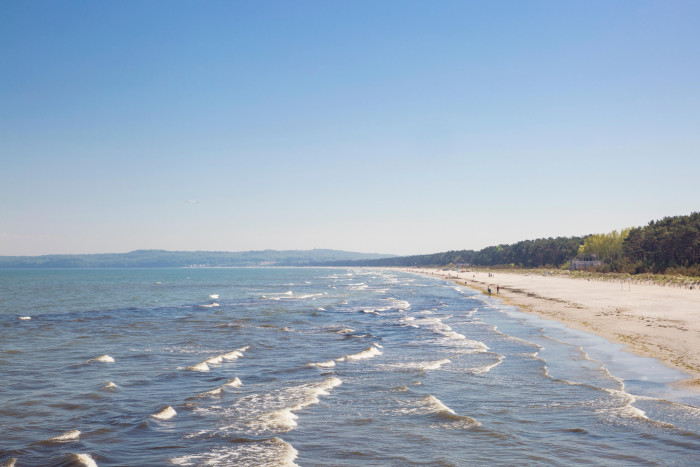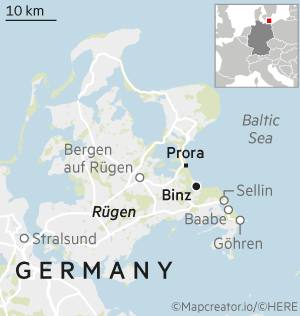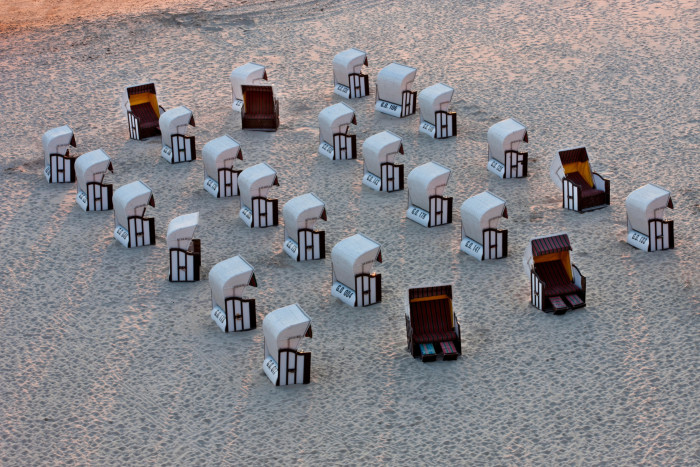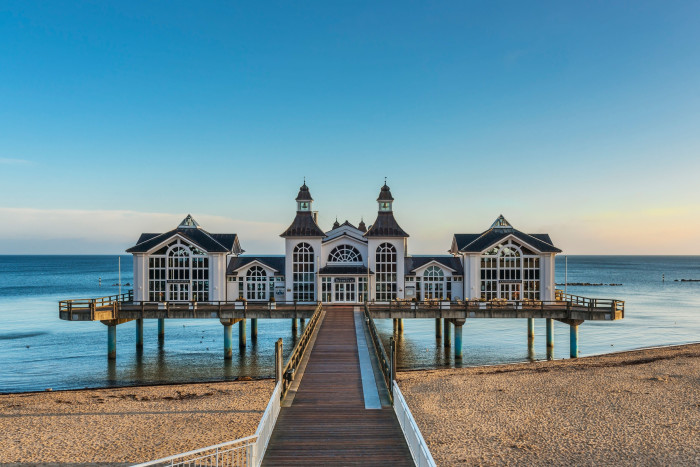There’s a beast of a building with a long, dark history on Germany’s Baltic coast. A building on the holiday island of Rügen which for the past 80 odd years has mostly been shunned, bombed, rated as top secret and then left to fall apart.
Conceived and built by the Nazi party as the longest building in the world — at 4.5km — the Colossus of Prora was intended to usher in a new era of tourism for the masses. It was to be an all-inclusive resort on an unprecedented scale, until the outbreak of the second world war stopped it in its tracks.
It was later garrisoned by Soviet troops, who blew up bits of it. Later it was occupied by the East German army and members of the Stasi, the secret police, which is why it didn’t appear on any maps. Its location was given away only by the presence of two railway stations that were apparently needlessly placed in the middle of a long strip of trees, plus brutal barbed wire blocking off the beach. All of which might explain why its rehabilitation has taken so long.
But recently this sleeping giant has been slipping off its dark cloak. In the course of the past decade, the five blocks still standing of the original eight — that’s 2.5km of building — have been reborn as a mix of hotel, youth hostel and luxury apartments. Finally, Prora is doing what it was originally conceived to do, bringing holidaymakers to one of the finest sandy beaches in northern Europe.

Despite its long dark history, my first impressions arriving at Prora are of a building that seems new and freshly painted. From the front — only 125 metres from the beach — serried rows of glass balconies glint in the sun, each six-storey block slightly different to its neighbour. At the back, where there is road access and car parks, are newly planted saplings and an endless repetition of protruding stairwells every 50 metres. Walking here, I feel like one of those tiny plastic figures in a giant architect’s model.

In Block II, I check in to a bright and spacious loft apartment in a section that’s become a spa hotel, the Solitaire, with hints of Scandi design and a bathroom almost as big as a squash court. The apartment is split-level, several times the size of the rooms that were originally planned, with a kitchenette replete with designer gadgetry. Outside, there’s a balcony on each of its levels, overlooking an outdoor swimming pool backed by a thin curtain of fir trees, through which a sandy track leads to a surprisingly under-frequented and pristine slice of beach. The rest of Prora extends on either side as far as the eye can see.
The Solitaire was one of the first bits of the reconstituted building to open, in 2016, while its neighbour and the only other hotel in the complex, the Dormero, followed in 2018. Both have a similar blueprint, offering a selection of self-catering suites, some of them very elaborate, with their own hot tubs but with shared spa, gym and indoor and outdoor swimming pools. The prices (from €698 per week for a two-person studio in the Solitaire) strike me as good value, though overall, with a layout that encourages guests to come and go through individual stairwells rather than the foyer, it feels more like a block of apartments than a hotel.


Prora was intended to have been the first of five mega-resorts, each one with 20,000 beds, created by the Nazis’ Kraft durch Freude (Strength through Joy) organisation. “He [Hitler] wanted to make propaganda out of concrete,” says historian and curator Marco Esseling, when I meet him at Prora’s documentation centre, where the exhibition MACHTUrlaub (“make holidays”) fills in the historical detail. The resort was built, says Esseling, both to impress and to make people feel grateful towards their leaders.
The location was chosen for obvious reasons: the beach here runs to some 10km of silky white sand, with a sea so clear, calm and shallow it can barely summon up the energy for a wave. Back in the early 20th century, it was already attracting holidaymakers — Rügen is only 200km north of Berlin — but these were the Prussian elite, who built themselves handsome villas in the fashionable spa settlement of Binz, at the beach’s south-eastern end.
Prora, on the other hand, was to be for the workers, says Esseling, with the proposed pricing affordable at 20 Reichsmarks for a week, including all meals and activities. That was about a quarter of the average monthly wage at the time.
The project was announced in 1935, Nazi party architect Clemens Klotz was appointed, and work started in 1936. As well as the eight linked blocks (long and thin so that almost every bedroom could have a sea view), there were to be two big swimming halls complete with artificial waves, two theatres, giant restaurants every 500 metres, a staff of 5,000 and a massive central Festhalle for rallies and celebrations.
Esseling walks me round the uncompleted central area, to the pillared hall that was to be the reception, and explains that the original design was such that some of the guests would have had to check in here, then walk as far as 2.2km through the interconnected buildings, carrying their luggage, to reach their rooms, a chore that would be unthinkable today. But then this was not going to be a place of holidays as we know them. The resort’s daily programme would have included parades and communal games. “But then war broke out, and nobody ever made their holidays here,” says Esseling.
After lunch at Kantine Prora (where a picture of Erich Honecker, a former leader of the GDR, hangs on the wall), I meet Rolf Hoffmeister from Binzprora, an investment company that was one of the earliest to buy into Prora back in 2005. He tells me that Binzprora bought the whole 500-metre Block III for a pittance at €350,000, but it was to be 12 years before the company actually started renovations, thanks to problems with planning and difficulties with Prora’s listed status. By contrast, the structure itself, despite its mistreatment and abandonment, was very sound.

Binzprora had wanted to include a marina in its development, but that was vetoed, and some of its plans for further new buildings in the historical central area, including a large sports hotel, are still under discussion. But all the company’s 250 apartments that fill Block III are due to be finished this year, and have long since been snapped up by purchasers. “In fact, I have had people who already have one, asking if they can buy more,” says Hoffmeister.
Do his customers have a clear idea of the history they are buying into? The developer looks doubtful. “I don’t think they are interested, they come here because of the beach. This place is for younger people, for whom the past is in the past. And we don’t see a conflict with Binz, it’s a different market.” Binz is for more elderly holidaymakers, he suggests. For those who may have longer memories.
Meetings done, I amble 3km down the beach, past lavish new lifeguard posts and regular signboards announcing textilfrei (nudist) stretches, which turn out to be under-frequented. In GDR times FKK, or Freikörperkultur (“free body culture”), was a big deal for people who wanted to experience some sense of freedom in the face of an unduly repressive state. Those days are gone.
Binz itself turns out to be a period piece, though its clientele has changed considerably since the elite first came here. The sand is demarcated with neat ranks of Strandkörbe, wicker beach chairs, which can be rotated like sunflowers to face the sun or turn their backs to the wind. There’s a pier, a bandstand outside the grand Kurhaus, and a shaded shoreside promenade that is lined with stalls selling trinkets and Milchreis, rice pudding with fruit purée.

Inland, villas of distinctive Bäder architecture, a mix of Art Nouveau and Long Island clapperboard, line its streets behind white picket fences, with ornate wooden balconies, rooftop gables, octagons, lanterns and domes.
I have a half day left of being a tourist here, so I contemplate taking the steamer from the end of Binz pier to the chalk cliffs of the Königsstuhl, or King’s Chair, which were memorably painted by Caspar David Friedrich, the 19th-century Romantic landscape painter whose canvases played a big part in making Rügen popular. But we’ve got chalk cliffs in England, and besides, I’m a bit of a closet trainspotter, so instead I board Rasender Roland (“Raging Roland”), a steam train that weaves its way along the coast to the subsidiary resorts of Sellin, Baabe and Göhren.
It’s a very pleasant ride, chugging past allotments and through thin forests of oak and beech, dappled with sunlight and laced with footpaths. I sit in an open carriage, listen to the murmur of conversation and admire the way the pillars of steam climb into the canopy of leaves.
Despite its name, this Raging Roland doesn’t really rage at all. In fact, it doesn’t seem even a little bit cross as it trundles along, tooting amiably at hikers and bikers. In this, it’s a bit like Prora, which may originally have been designed to impress and intimidate, but whose present manifestation has become something far more approachable. This is just a place for making holidays, after all.
Details
Andrew Eames was a guest of the German Tourist Office (germany.travel) and stayed at the Prora Solitaire Apartments and Spa (prora-solitaire.de). Studios for two at the Solitaire cost from €698 per week, rising to €1,070 per week for a split-level loft for four. The Dormero Strandhotel Rügen (dormero.de) has doubles from about €140 per night
Find out about our latest stories first — follow @ftweekend on Twitter
Stay connected with us on social media platform for instant update click here to join our Twitter, & Facebook
We are now on Telegram. Click here to join our channel (@TechiUpdate) and stay updated with the latest Technology headlines.
For all the latest Travel News Click Here
